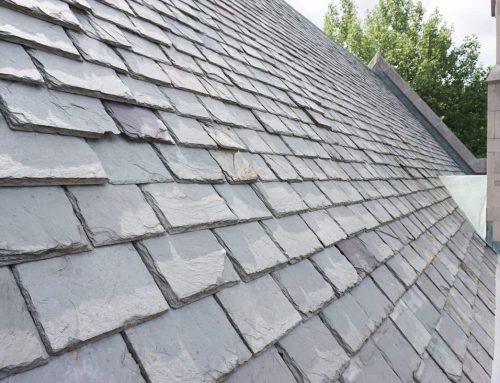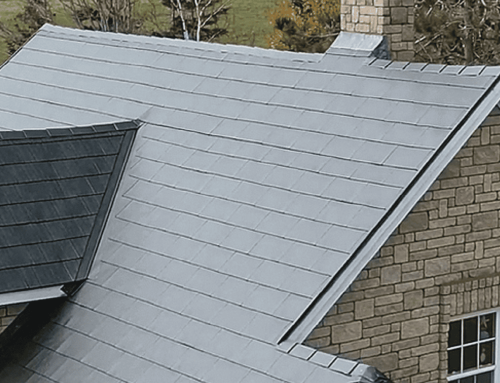The morning after a severe storm in Toronto often reveals a landscape transformed by nature’s power—broken tree branches scattered across yards, debris filling streets, and the ominous sight of damaged roofing materials clinging to fence lines or littering driveways. While the immediate danger has passed, the real challenge for homeowners begins with assessing what the storm has left behind and understanding that even seemingly minor roof damage can quickly escalate into major problems if left unaddressed.
Storm Damage Assessment Guide
Immediate Safety Concerns:
- Sagging or visibly damaged roof sections
- Fallen power lines near your property
- Large debris on the roof that could shift
- Water actively entering your home
- Structural damage to walls or foundations
Common Toronto Storm Damage Types:
- Missing or damaged asphalt shingles
- Dented metal roofing from hail impact
- Damaged flashing around chimneys and vents
- Clogged or damaged gutters and downspouts
- Punctures from falling branches or debris
What to Look for After Storms:
- Granules in gutters and around your home’s perimeter
- Exposed nail heads or lifted shingle edges
- Cracked or split roofing materials
- Dents in metal surfaces (gutters, vents, flashing)
- Interior water stains or active leaks
Toronto’s position in southern Ontario places it directly in the path of severe weather systems that regularly pummel the Greater Toronto Area with damaging winds, large hail, and intense rainfall. These storms don’t just create immediate visible damage—they often compromise your roof’s integrity in ways that may not become apparent until the next weather event tests these weakened areas. Understanding how to respond quickly and effectively can mean the difference between minor repairs and major reconstruction projects.
Toronto’s Storm Patterns and Roof Vulnerabilities
The Greater Toronto Area experiences a unique combination of weather patterns that create perfect conditions for roof-damaging storms throughout much of the year. Understanding these patterns helps homeowners prepare for potential damage and respond appropriately when storms strike.
Severe Thunderstorm Seasons
Toronto’s storm season typically runs from late spring through early fall, with peak activity occurring during June, July, and August. During these months, the collision of warm, humid air masses from the south with cooler air from the north creates ideal conditions for severe thunderstorm development. These storms often produce damaging straight-line winds exceeding 100 km/h, hail ranging from pea-sized to golf ball diameter, and rainfall rates that can overwhelm even well-maintained drainage systems.
The speed at which these storms develop and move through the GTA often catches homeowners unprepared. A sunny morning can quickly transform into a severe weather event by afternoon, with little warning time for protective measures. This rapid onset means that roof damage often occurs when homeowners are unable to take preventive action, leaving properties vulnerable to the full force of storm conditions.
Microbursts, concentrated downdrafts of air that spread outward upon hitting the ground, create particularly devastating wind damage in localized areas. These events can produce winds exceeding 150 km/h over areas just a few kilometers wide, creating pockets of severe damage while leaving nearby properties relatively unaffected.
Winter Storm Impacts
While summer storms grab headlines, Toronto’s winter weather creates its own set of roofing challenges that can cause significant damage. Ice storms, which occur when freezing rain coats surfaces with thick layers of ice, add enormous weight to roofing systems while making materials brittle and prone to cracking.
The weight of accumulated ice and snow can exceed design loads, particularly on older homes or structures with compromised roofing systems. When combined with freeze-thaw cycles that occur during winter warm spells, this loading can cause structural damage that may not become apparent until spring inspection reveals cracked rafters, sagging roof decking, or damaged support structures.
Rapid temperature changes during Toronto’s unpredictable winter weather create thermal stress that affects all roofing materials. Asphalt shingles become brittle in extreme cold, making them vulnerable to cracking when subjected to wind or impact forces. Metal roofing expands and contracts with temperature changes, potentially loosening fasteners or creating stress points that fail during subsequent storms.
Spring Flooding and Water Damage
Toronto’s spring weather often brings rapid snowmelt combined with heavy rainfall that can overwhelm drainage systems and create conditions for water damage even on roofs that appeared to survive winter storms intact. Ice dams that formed during winter may have created entry points for water infiltration that only become apparent when spring rains test these compromised areas.
The freeze-thaw cycle that characterizes Toronto’s spring weather can expand small cracks or gaps created by winter storms, turning minor damage into significant problems. Flashing that shifted slightly during winter storms may develop leaks when subjected to spring rains, while shingles that lifted during winter winds may allow water infiltration once warmer weather makes them more flexible.
Identifying Common Storm Damage Types
Storm damage to Toronto roofs manifests in numerous ways, ranging from obvious visible destruction to subtle problems that may not become apparent until subsequent weather events stress the compromised areas. Understanding these damage types helps homeowners assess the urgency of repairs and communicate effectively with contractors and insurance adjusters.
Wind Damage Assessment
High winds represent the most common cause of storm damage in the Toronto area, with different roofing materials showing characteristic failure patterns that help identify the extent of problems. Asphalt shingles typically show wind damage through lifted edges, missing shingles, or exposed nail heads where wind has worked under the shingle edges and gradually loosened the attachment points.
Three-tab shingles, being lighter and less flexible than architectural shingles, often show more extensive wind damage from moderate storm events. Look for shingles that appear to have been folded back on themselves, creating creases that indicate the material has been stressed beyond its design limits. These creased shingles will likely fail completely during the next significant wind event, making prompt replacement important.
Architectural shingles may show more subtle wind damage, with slight lifting at the edges or small tears where the laminated layers have begun to separate. While these may appear minor, they create starting points for wind to gain purchase during future storms, potentially leading to more extensive damage if not addressed promptly.
Metal roofing typically shows wind damage through loosened fasteners, damaged seams, or panels that have shifted from their original positions. While metal roofing generally performs better in high winds than shingles, improperly installed systems or those with aging fasteners can experience significant damage during severe storms.
Hail Damage Recognition
Hail damage creates distinct patterns that vary based on the size and density of the hailstones, the angle of impact, and the type of roofing material affected. On asphalt shingles, hail damage typically appears as circular impacts where granules have been knocked off, exposing the underlying mat material. Fresh hail damage shows sharp edges around the impact points, while older damage may have weathered edges that indicate the roof has been compromised for some time.
The pattern of hail damage across your roof can help determine the severity of the storm and the likelihood of widespread problems. Isolated impacts suggest smaller hail or a brief storm, while dense patterns of damage covering large roof areas indicate significant hail that likely affected the entire roofing system.
Metal roofing shows hail damage through denting that may affect both the appearance and function of the system. While small dents may seem purely cosmetic, they can create low points where water collects and potentially leads to premature corrosion or drainage problems.
Gutters and downspouts often show the most obvious hail damage, with dents and dings that provide clear evidence of the storm’s intensity. This visible damage can serve as an indicator that less obvious roof damage may also be present, warranting closer inspection of the entire roofing system.
Debris Impact and Puncture Damage
Toronto’s urban forest makes debris impact a significant concern during severe storms. Falling branches, airborne patio furniture, or other storm-driven objects can create puncture damage that immediately compromises your roof’s weather protection. These impacts may create obvious holes that require immediate temporary protection, or they may cause subtle damage like cracked shingles or dented metal that allows water infiltration.
Large debris that remains on your roof after a storm poses ongoing risks beyond the initial impact damage. The weight of fallen branches can stress roofing materials and support structures, while the debris itself can shift during subsequent weather events, causing additional damage as it moves across the roof surface.
Even apparently minor debris impacts can have significant consequences if they damage flashing around roof penetrations or create starting points for wind to lift roofing materials during future storms. Small punctures may seem manageable, but they often indicate broader impact damage that requires professional assessment to fully understand.

The Dangers of Delayed Repairs
Postponing storm damage repairs in Toronto’s climate creates a cascade of problems that typically cost far more to address than the original storm damage itself. Understanding these consequences helps homeowners prioritize repair work and avoid the false economy of temporary fixes.
Water Infiltration and Structural Damage
Any compromise to your roof’s weather barrier allows Toronto’s frequent precipitation to begin causing damage that extends far beyond the roofing system itself. Water that enters through storm-damaged areas can quickly saturate insulation, reducing its effectiveness and creating conditions for mold growth that affects indoor air quality throughout your home.
Once water penetrates the roof system, it often travels along rafters, wall studs, or other structural components before becoming visible inside your home. This hidden water damage can weaken structural elements over time, leading to costly repairs that extend far beyond simple roof replacement.
The freeze-thaw cycle that characterizes much of Toronto’s year accelerates water damage in roof systems compromised by storm damage. Water that enters through small openings expands when it freezes, widening gaps and creating larger entry points for subsequent precipitation. This cycle can quickly transform minor storm damage into major structural problems.
Secondary Storm Vulnerability
A roof compromised by storm damage becomes increasingly vulnerable to subsequent weather events that might not affect an intact roofing system. Loose shingles can be completely removed by moderate winds that wouldn’t normally cause damage, while small punctures can allow wind-driven rain to enter areas that should remain dry.
Toronto’s frequent storm activity means that damaged roofs often face multiple weather challenges before repairs can be completed. Each subsequent storm event can worsen existing damage, creating a situation where repair costs escalate rapidly and temporary protective measures become inadequate.
The cumulative effect of multiple storm events on already-damaged roofing systems often results in failure patterns that extend beyond the original damage area. What begins as isolated shingle damage can spread across large roof sections as wind finds purchase points at damaged areas and progressively removes additional materials.
Insurance and Documentation Challenges
Insurance companies typically require prompt notification of storm damage and may limit coverage for secondary damage that results from delayed repairs. Waiting to address storm damage can complicate insurance claims and potentially reduce coverage for related problems that develop over time.
Documenting storm damage immediately after weather events provides the strongest foundation for insurance claims and helps establish the timeline of damage development. Delayed reporting can raise questions about the cause of damage and may result in disputed claims or reduced settlements.
Weather-related damage that goes unrepaired often develops into maintenance issues that fall outside insurance coverage. What begins as a covered storm damage claim can evolve into an excluded maintenance problem if repairs are postponed beyond reasonable timeframes.
Professional Assessment and Insurance Claims
Navigating the insurance claims process for storm damage requires understanding both the extent of damage and the documentation requirements that support successful claims. Professional assessment provides the foundation for both repair planning and insurance recovery.
Comprehensive Damage Documentation
Professional roofing contractors experienced in storm damage assessment can identify problems that homeowners might overlook while providing the detailed documentation that insurance companies require for claims processing. This assessment should include both obvious damage and subtle indicators of compromised roofing system performance.
Photographic documentation should capture both overall roof conditions and close-up views of specific damage areas, with sufficient detail to support insurance claims and guide repair work. Professional contractors understand the documentation standards that insurance adjusters expect and can provide reports that facilitate claims processing.
Measurement and quantification of damaged areas helps establish repair scope and cost estimates that support insurance claims while ensuring that all necessary work is included in restoration planning. Detailed assessments prevent overlooked damage that might not be discovered until repair work begins.
Insurance Claim Strategy
Working with contractors experienced in insurance claims can help homeowners navigate the complex requirements and timelines that govern storm damage coverage. These professionals understand policy language, coverage limitations, and documentation requirements that affect claim outcomes.
Insurance adjusters rely on professional assessments to evaluate damage extent and appropriate repair methods, making contractor expertise crucial for achieving fair settlements. Contractors who regularly work with insurance companies can communicate effectively with adjusters and provide the technical information needed for claim evaluation.
Understanding your insurance policy’s requirements for emergency repairs, temporary protection, and contractor selection helps ensure that your response to storm damage preserves coverage options and maximizes recovery potential.
Protecting Your Home
Storm damage, while disruptive and concerning, often provides an opportunity to improve your home’s resilience against future weather events while restoring the protection and value that your roof provides. Taking appropriate action quickly and working with experienced professionals ensures that your response to storm damage supports your home’s long-term performance and your family’s safety.
The key to successful storm damage recovery lies in prompt assessment, appropriate emergency response, and comprehensive restoration that addresses both immediate damage and underlying vulnerabilities. Toronto’s storm patterns make this preparation and response capability essential for protecting your investment and maintaining your peace of mind.
If your home has experienced storm damage or you want to prepare for Toronto’s next severe weather event, contact Ontario Downspout Service today.







